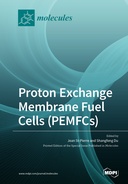Explore

Proton Exchange Membrane Fuel Cells (PEMFCs)
0 Ungluers have
Faved this Work
Login to Fave
The proton exchange membrane fuel cell is an electrochemical energy conversion device, which transforms a fuel such as hydrogen and an oxidant such as oxygen in ambient air into electricity with heat and water byproducts. The device is more efficient than an internal combustion engine because reactants are directly converted into energy through a one-step electrochemical reaction. Fuel cells combined with water electrolyzers, which electrochemically split water into hydrogen and oxygen using renewable energy sources such as solar, mitigate global warming concerns with reduced carbon dioxide emissions. This collection of papers covers recent advancements in fuel cell technology aimed at reducing cost, improving performance, and extending durability, which are perceived as crucial for a successful commercialization. Almost all key materials, as well as their integration into a cell, are discussed: the bus plates that collect the electrical current, the gas diffusion medium that distributes the reactants over catalysts promoting faster reactions, and the membrane separating oxygen and hydrogen gases and closing the electrical circuit by transporting protons. Fuel cell operation below the freezing point of water and with impure reactant streams, which impacts durability, is also discussed.
This book is included in DOAB.
Why read this book? Have your say.
You must be logged in to comment.
Rights Information
Are you the author or publisher of this work? If so, you can claim it as yours by registering as an Unglue.it rights holder.Downloads
This work has been downloaded 141 times via unglue.it ebook links.
- 141 - pdf (CC BY) at Unglue.it.
Keywords
- asymmetric &
- Automotive
- carbon-free
- catalyst layer
- catalyst loading
- cathode
- cathode catalyst layer
- Chemical engineering
- composite membranes
- computational fuel cell dynamics
- conductivity limitation
- Contamination
- current collector
- dead-ended anode (DEA) mode
- diffusion limitation
- durability
- electrolysers
- electrolyte
- Freudenberg
- Fuel cells
- fuel impurities
- graphene thin film
- I/C ratio
- Industrial Chemistry
- Industrial chemistry & manufacturing technologies
- ionomer thin film
- ISO concentration
- isothermal water fill tests
- membrane electrode assembly (MEA)
- Module
- nitrogen dioxide
- oxygen evolution
- oxygen reduction
- oxygen reduction reaction kinetics
- oxygen transport resistance
- PEM
- PEM fuel cell
- PEM water electorolyzer
- PEMFCs
- Performance
- platinum electrode
- platinum ionomer interface
- polymer electrolyte fuel cell
- porous structure
- proton exchange membrane fuel cell
- proton exchange membrane fuel cells
- Recovery
- response surface method
- SGL 29BC
- shut-down and start-up process
- subzero cold-starts
- symmetric GDM
- Technology, engineering, agriculture
- Technology: general issues
- ultralow-loaded anode catalyst layer
Links
DOI: 10.3390/books978-3-0365-1543-4Editions

